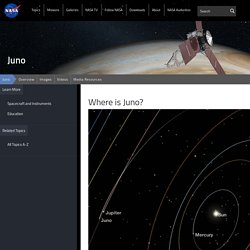

The Moon Rotating. NASA Live - Earth From Space (HDVR) ISS LIVE FEED #AstronomyDay2017. Jupiter: Juno Perijove 06. Spacex NROL-76 Launch Webcast. Name that Space Rock. 184623-The-Planets-If-They-Were-As-Far-Away-From-Earth-As-The-Moon. Rocket seen from plane. 4th Dimension - Tesseract, 4th Dimension Made Easy - Carl Sagan. Soyuz capsule docking with the ISS. Space Engine - Home page. 12 hours on Earth as seen from geostationary orbit. The Incredible Shrinking Mercury is Active After All. The planet Mercury is being pelted regularly by bits of dust from an ancient comet, a new study has concluded.

This has a discernible effect in the planet’s tenuous atmosphere and may lead to a new paradigm on how these airless bodies maintain their ethereal envelopes. The findings are to be presented at the annual Meeting of the Division of Planetary Sciences of the American Astronomical Society at National Harbor, Maryland, this week, by Apostolos Christou at the Armagh Observatory in Northern Ireland, Rosemary Killen at NASA’s Goddard Space Flight Center in Greenbelt, Maryland, and Matthew Burger of Morgan State University in Baltimore, working at Goddard.
The 1995 Hubble photo that changed astronomy. Tmelapse at Mauna Kea observatory - GIF on Imgur. Milky Way. Zoom to the Moon. Why You Should Put YOUR MASK On First (My Brain Without Oxygen) - Smarter Every Day 157. Elliptical orbits of the planets. Temperatures from absolute cold to absolute hot. Jupiter. Rosetta comet probe given termination date. Image copyright ESA The Rosetta probe will be crash-landed on Comet 67P on Friday 30 September, the European Space Agency has confirmed.

The manoeuvre, which is expected to destroy the satellite, will bring to an end two years of investigations at the 4km-wide icy dirt-ball. Flight controllers plan to have the cameras taking and relaying pictures during the final descent. Sensors that "sniff" the chemical environment will also be switched on. All other instruments will likely be off.
Where is Juno? As of May 6, 2016, Juno is approximately 450 million miles (724 million kilometers) from Earth.

The one-way radio signal travel time between Earth and Juno is currently about 40 minutes. Juno is traveling at a velocity of approximately 60,000 miles per hour (about 26.9 kilometers per second) relative to Earth, 15,000 miles per hour (about 6.7 kilometers per second) relative to the Sun, and 13,000 miles per hour (about 6 kilometers per second) relative to Jupiter. Juno has now travelled 1.74 billion miles (2.8 billion kilometers, or 18.73 AU) since launch, and has another 19 million miles to go (31 million kilometers, or 0.20 AU) before entering orbit around Jupiter. The Juno spacecraft is in excellent health and is operating nominally. Are You Living in a Simulation? Many works of science fiction as well as some forecasts by serious technologists and futurologists predict that enormous amounts of computing power will be available in the future.

Let us suppose for a moment that these predictions are correct. One thing that later generations might do with their super-powerful computers is run detailed simulations of their forebears or of people like their forebears. Earth Rotation. Moon Despina casts it's shadow on Neptune. Is the Solar System Really a Vortex? - Universe TodayUniverse Today. The short answer?

No. Not in the way that a popular animated gif insinuates, at least. If you’re even a casual space fan you may have seen a viral gif animation showing our solar system traveling through space, the motions of the planets tracing corkscrew “vortex” paths around a line-driving Sun. Solar system's Ecliptic vs Galactic Plane.